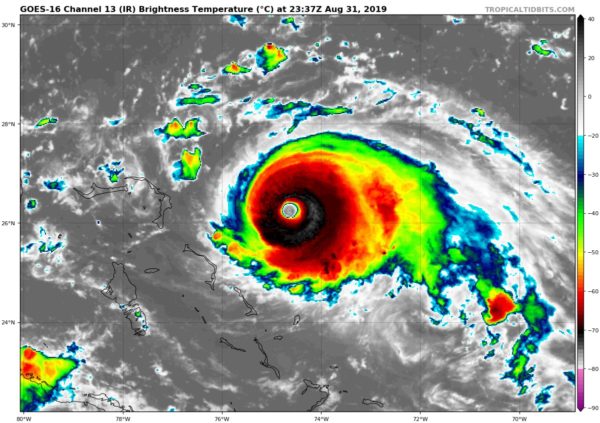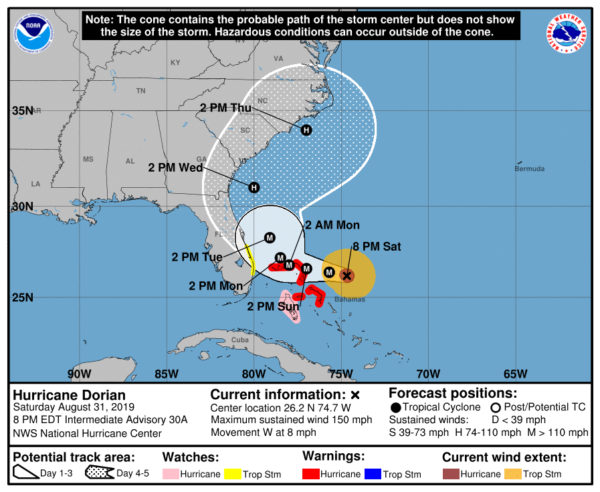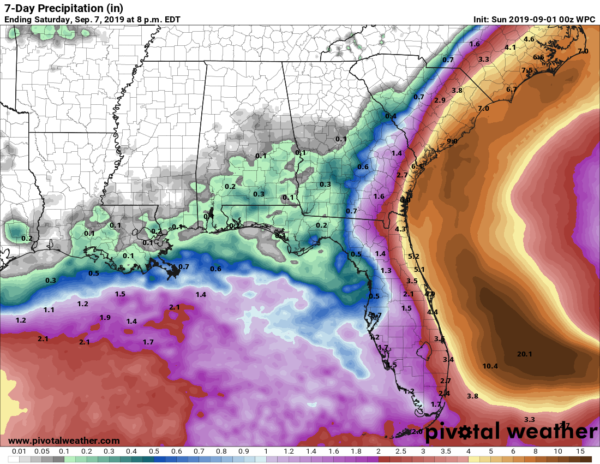An Evening Look At Hurricane Dorian, Remaining A Category 4 Hurricane
We continue to have a very impressive looking and very dangerous hurricane moving to the west and starting to approach the eastern portions of the Bahamas. As of the 7:00 pm CT update, Dorian is at Category 4 strength with maximum sustained winds clocking in at 150 MPH. Movement is to the west at 8 MPH and the minimum central pressure is at 941 MB (27.79 in).
While the news has been a little better throughout the day today with the official forecast track continuing to track a little farther east and keeping the center offshore of the Southeastern US Atlantic coast, we do have to remember that any little jog farther to the west before the turn to the northwest and north occurs will bring stronger winds and storm surge to the Florida Peninsula and to the Georgia and Carolina shores.
Even with Dorian following the current forecast track which keeps the eye remaining well-offshore, we will still see plenty of heavy rainfall along the coastal sections of the southeastern United States, along with deadly rip currents, rough seas, and the potential for a life-threatening storm surge.
The latest 7-day precipitation forecast for the southeastern US from the WPC shows that the heavier amounts along the coast and just inland from the southern tip of Florida to the outer shores of North Carolina. Those amounts are ranging from as little as 2.00 inches to as much as 8.00 inches where more of the storm moves onshore in the Carolinas.
With this forecast, there will be no effects from Dorian felt in the state of Alabama or along the Gulf Coast. We may see a few clouds and maybe a little breeze during next week, but not much at all.
Here is the latest forecast advisory from the National Hurricane Center:
SUMMARY OF 800 PM EDT…0000 UTC…INFORMATION
LOCATION…26.2N 74.7W
ABOUT 155 MI…245 KM E OF GREAT ABACO ISLAND
ABOUT 335 MI…540 KM E OF WEST PALM BEACH FLORIDA
MAXIMUM SUSTAINED WINDS…150 MPH…240 KM/H
PRESENT MOVEMENT…W OR 275 DEGREES AT 8 MPH…13 KM/H
MINIMUM CENTRAL PRESSURE…941 MB…27.79 INCHES
WATCHES AND WARNINGS
A Hurricane Warning is in effect for… Northwestern Bahamas excluding Andros Island
A Hurricane Watch is in effect for… Andros Island
A Tropical Storm Watch is in effect for… Deerfield Beach to Sebastian Inlet
DISCUSSION AND OUTLOOK
At 800 PM EDT (0000 UTC), the distinct eye of Hurricane Dorian was located near latitude 26.2 North, longitude 74.7 West. Dorian is moving toward the west near 8 mph (13 km/h), and a slower westward motion should continue for the next day or two, followed by a gradual turn toward the northwest. On this track, the core of Dorian should be near or over portions of the northwestern Bahamas on Sunday, and move closer to the Florida east coast late Monday through Tuesday.
Data from NOAA and Air Force Hurricane Hunter aircraft indicate that the maximum sustained winds remain near 150 mph (240 km/h) with higher gusts. Dorian remains a category 4 hurricane on the Saffir-Simpson Hurricane Wind Scale. Some fluctuations in intensity are likely, but Dorian is expected to remain a powerful hurricane during the next few days.
Hurricane-force winds extend outward up to 30 miles (45 km) from the center and tropical-storm-force winds extend outward up to 105 miles (165 km).
The latest minimum central pressure reported by reconnaissance aircraft is 941 mb (27.79 inches).
HAZARDS AFFECTING LAND
WIND: Hurricane conditions are expected in the hurricane warning area across the northwestern Bahamas by Sunday, with tropical storm winds beginning tonight.
Tropical storm conditions are possible within the tropical storm watch area on Monday.
STORM SURGE: A life-threatening storm surge will raise water levels by as much as 10 to 15 feet above normal tide levels in areas of onshore winds the Abaco Islands and Grand Bahama Island. Near the coast, the surge will be accompanied by large and destructive waves.
RAINFALL: Dorian is expected to produce the following rainfall accumulations this weekend into the middle of next week:
Northwestern Bahamas…10 to 15 inches, isolated 25 inches.
Coastal sections of the southeast United States…4 to 8 inches, isolated 12 inches.
Central Bahamas…2 to 4 inches, isolated 6 inches.
This rainfall may cause life-threatening flash floods.
SURF: Swells will begin affect the east-facing shores of the Bahamas, the Florida east coast, and the southeastern United States coast during the next few days. These swells are likely to cause life-threatening surf and rip current conditions. Please consult products from your local weather office.


















